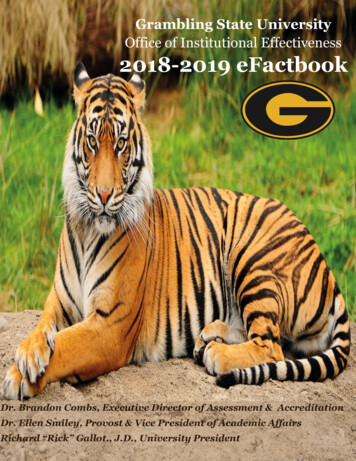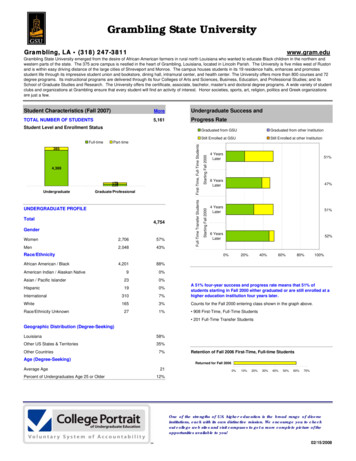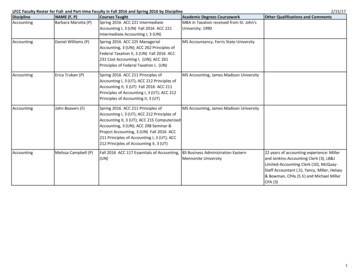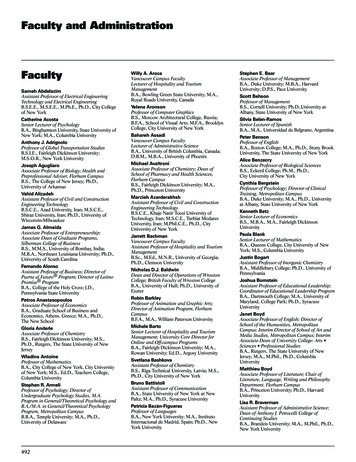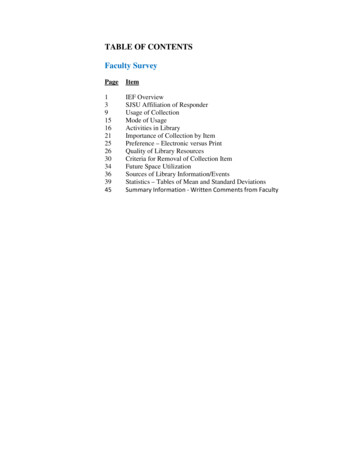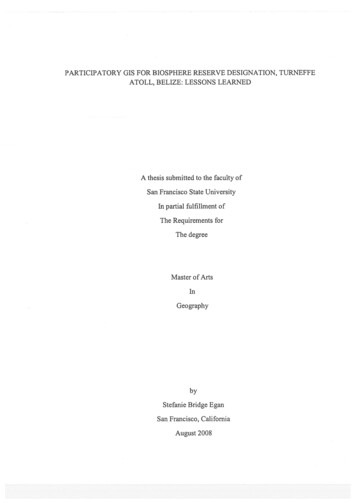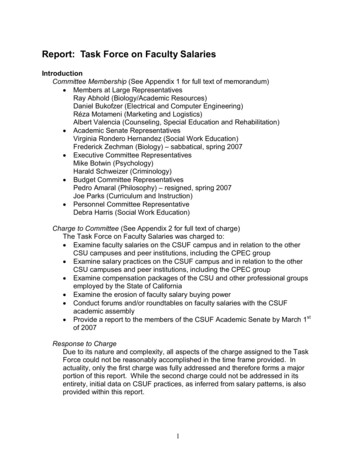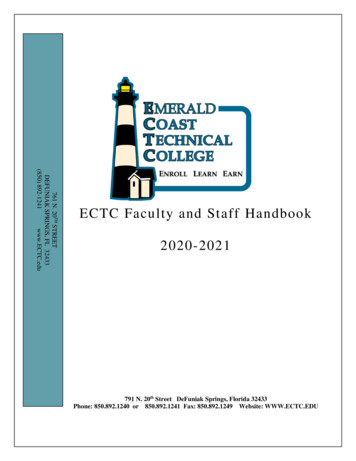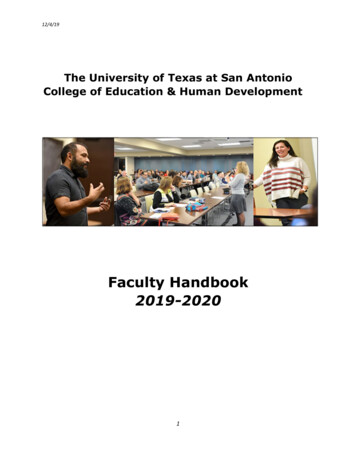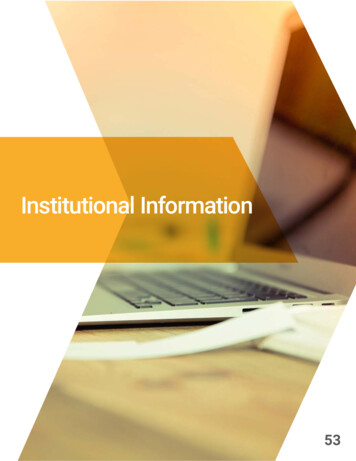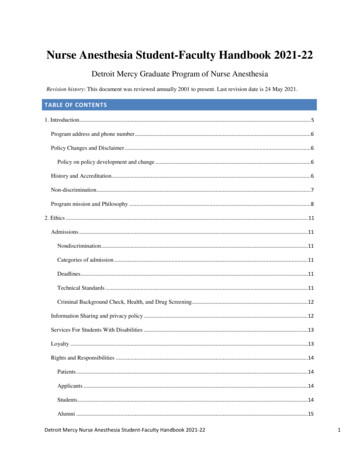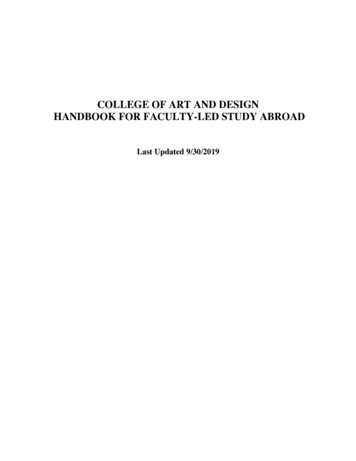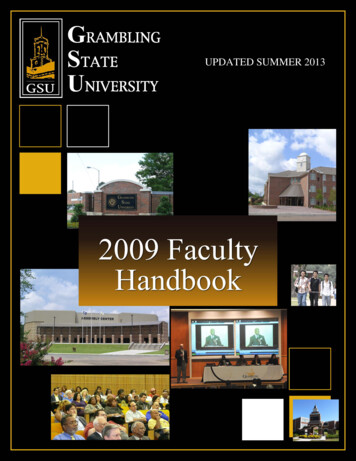
Transcription
UPDATED SUMMER 2013
GRAMBLING STATE UNIVERSITYFACULTY HANDBOOK2009Updated Summer 2013i
COMPENSATION TABLES FORGRADUATE COURSESCompensation of Department Heads during the SummerAcademic Department Heads, each summer session, will be eligible to receive administrative pay of 4,333 foradministrative duties performed. The Department Head must also teach at least one course (not more than 2courses) to be eligible to receive the administrative pay for a summer session. The administrative pay forSummer Session I will be prorated to take into consideration that part of Summer Session I overlaps with theadministrative pay the Department Head receives as a 10 month employee.AwardsTo recognize and encourage excellence in teaching, research, and service the University established at the end ofthe 2005-06 academic year the Faculty Awards Program. Through this program faculty members who havemade significant contributions and/or achievements will receive awards at the annual Faculty AppreciationDinner, which is usually held late in the spring semester. Only one award will be given in each area (teaching,research, service) and a given faculty member can only receive recognition for achievement in one area. Theaward for excellence in each of the three areas is 5,000.The metrics that will be used to determine outstanding teaching will involve student evaluations, studentperformance, and peer reviews. They may also involve the development of teaching materials such as textbooks,laboratory manuals, monographs, software, and demonstrations, and innovative teaching methods, publicationsin refereed journals on teaching innovations, etc.The metrics that will be used to determine outstanding research will involve peer reviews of how the researchcontributes to the advancement of knowledge in a given field, publications in refereed journals which are cited,published books and monographs, grant and contract support, etc.The measurement of outstanding service will involve peer reviews of the service with analyses of distinguishingfeatures, the impact of the service (the number of people/organizations who benefit), and the consistency of theservice with the mission of the University.29
CHAPTER IXADDENDUMS83
INSTITUTIONAL EFFECTIVENESS COMMITTEEThe Institutional Effectiveness Committee is a university standing committee. Committee members areappointed by the university president to serve a two-year renewable term. The IE Committee reports tothe Associate Vice President for Planning and Institutional Research who serves as an ex-officio member.The committee’s primary function is to engage all university units in an integrated on-going assessmentprocess.Primary Responsibilities of the Committee are to:1. Manage the implementation of the outcomes assessment system (TracDat)2. Ensure that assessment of each unit, both academic and non-academic, is ongoing andintegrated3. Provide assistance to units with the development of their mission and assessment plans toensure that they are aligned with the University mission and goals4. Review the results of assessment findings to ensure the validity and reliability of theassessment procedures5. Develop benchmarks for standard data analysis6. Recommend changes for improvement based on an analysis of data7. Work in collaboration with the President’s 21st Century Planning committee84
GRMvtBUNGSTATEPolicy # 55003UNIVERSITYGRAMIIUNG.LOUISIANAEffective Date: August 1, 2007Responsible Office: Grants AdministrationDivision: FinanceGrambling State University recognizes the need for and desirability of encouraging thebroad utilization of the results of academic research by bringing innovative findings topractical application. The primary purpose of this Intellectual Property Policy is toprovide the necessary protections and incentives to encourage both the discovery anddevelopment of new knowledge and its transfer for the public benefit; a secondarypurpose is to enhance the generation of revenue for the horne institutions and the creators.Grambling State University recognizes that research and scholarship should beencouraged without regard to potential gain from licensing fees, royalties, or otherincome; however, the System also recognizes that intellectual properties and discoveriesmay arise from the activities of faculty, staff, and students in the course of the duties orthrough the use, by any person, of institutional resources such as facilities, equipment, orfunds. The policies governing the administration of such intellectual properties shouldprovide adequate recognition and incentive to creators and, at the same time, ensure thatthe University will share in the rights pertaining to intellectual properties in which theyhave equity. Grambling State University is committed to assisting its faculty and otherresearchers in properly disclosing their scholarly work, in complying with applicablelaws and formal agreements, and in gaining the protection available under the UnitedStates laws governing patents, copyrights, trademarks, and other appropriate provisions.Grambling State University's Intellectual Property Policy seeks to accomplish thefollowing objectives in compliance with applicable state and federal guidelines:A. To encourage research and scholarship as creative academic endeavors whilerecognizing that commercially valuable intellectual properties may result fromsuch endeavors;B. To delineate procedures to encourage creators to report discoveries with broadcommercial potential and public benefit and to assist them, while at the same timesafeguarding the interests of all concerned parties;85
POLICY #55003INTELLECTUAL PROPERTY/COPYRIGHTC. To make intellectual property developed in the course of academic researchavailable to the public under conditions that will promote its effective and timelyuse and development;D. To optimize the environment and incentives for research and scholarly activityand for the creation of new knowledge in the System institutions;E. To ensure that the educational mission of Grambling State University isreinforced.The following definitions shall govern throughout the Grambling State UniversityIntellectual Property Policy.A. Intellectual Property shall be defined as inventions, discoveries, know-how, showhow, processes, unique materials, copyrightable works, original data, and othercreative or artistic works that have value. Intellectual property includes that whichis protectable by statute or legislation, such as patents, copyrights, trademarks,service marks, trade secrets, mask works, and plant variety protection certificates.It also includes the physical embodiments of intellectual effort, for example,models, machines, devices, designs, apparatus, instrumentation, circuits, computerprograms and visualizations, biological materials, chemicals, other compositionsof matter, plants, and records of research.B. Traditional Academic Copyrightable Works shall be defined as a subset ofcopyrightable works created independently and at the creator's initiative fortraditional academic purposes. Examples include class notes; books, theses anddissertations; articles; non-fiction, fiction, and poems; musical works; dramaticworks including any accompanying music; pantomimes and choreographic works;pictorial, graphic, and sculptural works; or other works of artistic imagination thatare not created as an institutional initiative.C. Creator shall be defined as an individual or group of individuals who make,conceive, reduce to practice, author, or otherwise make a substantive intellectualcontribution to the creation of intellectual property. "Creator" shall include, butnot be limited to, faculty, professional staff, administrative and support staff, andstudents. "Creator" shall also include the definition of "inventor" as used in theU.S. patent law and the definition of "author" as used in the U.S. Copyright Act.D. Institution Resources Usually and Customarily Provided shall include suchsupport as office space, library facilities, ordinary access to computers andnetworks, or salary and shall be described in this policy as either "incidental" or"significant." The phrase does not include use of students or employees as supportstaff to develop the work, or substantial use of specialized or unique facilities and86
POLICY #55003INTELLECTUAL PROPERTY/COPYRIGHTequipment, or other special subventions provided by the institution unlessapproved as an exception.E. Technical Works shall include intellectual properties that are of a scientific,engineering, or technical nature such as patentable or unpatenable inventions(including biological materials), computer software, and institution collections.F. Scholarly Works shall include all intellectual properties not covered in TechnicalWorks that are of an artistic, scholarly, instructional, or entertainment nature.G. Computer Software shall include one or more computer programs existing in anyform or any associated operational procedures, manuals, or other documentation,whether protectable or protected by patent or copyright.A. OverviewGrambling State University has ownership of intellectual property created (a) by anemployee within the scope of his or her employment, (b) by an employee who is hired orcommissioned to create a specific work, (c) when more than incidental use of institutionresources usually and customarily provided occurs, or (d) when the intellectual propertyresults from research supported by federal funds or third-party sponsorship. GramblingState University shall not assert ownership of intellectual property unrelated to jobresponsibilities and where only incidental use of institution resources usually andcustomarily provided, has occurred, nor does it have ownership of traditional academiccopyrightable works. (See principles below; Grambling State University does have theright to recover costs and/or right to use the work.) Joint ownership may occur undercertain circumstances such as when scholarly works involve the services of otherinstitution employees (e.g., development of multi-media courseware).B. Principles1. This policy shall apply to all persons employed by Grambling State University, toanyone using its facilities under the supervision of institution personnel, toundergraduates, and to graduate students.2. Grambling State University may assert ownership in intellectual property of all types(including, but not limited to, any invention, discovery, trade secret, technology,scientific or technological development, and computer software) regardless of whetherthe property is subject to protection under patent, trademark, copyright, or other laws,except as stipulated in Sections 3, 4, 5, and 6 which will follow.3. Grambling State University may assert its interest in intellectual property related to thecreator's academic or professional field, regardless of the medium of expression. TheUniversity shall have ownership of all intellectual property created by persons under theconditions stated below:87
POLICY #55003INTELLECTUAL PROPERTY/COPYRIGHT(a) if intellectual property is created by an employee within the specific scope ofemployment; or(b) if intellectual property is created with the use of institution facilities usuallyand customarily provided; or(c) if intellectual property is commissioned by the institution pursuant to a signedcontract; or(d) if intellectual property is created by a person who was hired specifically, or isrequired as part of his or her job responsibilities, to produce it; or(e) if intellectual property fits within one of the nine categories of worksconsidered "works for hire" under copyright law!; or(f) if intellectual property results from research supported by federal funds orthird-party sponsorship.NOTE: Works related to an employee's job responsibilities, even ifhe or she is notspecifically requested to create them, will belong to the institution as works-for-hire. Acopyright work is related to an employee's job responsibilities ifit is the kind of work anemployee is employed to do and if the work is done, at least in part, for use at work or foruse by fellow employees, the employer, or the employee's clients. Use of personal timeor other facilities to create the work will not change its basic nature if the work is relatedto the creator's job as described above. Works that have nothing to do with job duties willremain the property of the creator, so long as he or she makes no more than the incidentaluse of institution facilities usually and customarily provided.4. Grambling State University shall not have ownership when the creator is a student,professional, faculty, or non-faculty researcher and the intellectual property is atraditional academic copyrightable work in the creator's field of experience. Even thoughsuch a work may be within the scope of employment, it is the property of the creatorunless it is a scholarly work (a) created by someone who was specifically hired orrequired to create it or (b) commissioned by the institution. In either of these cases, theinstitution, not the creator, will own the intellectual property.NOTE: The use of the terms "professionals" and "researcher," together with facultymembers and students, is intended to encompass all those individuals who routinelycreate scholarly works (e.g., educational, artistic, musical, literary, or architectural work).For example, if a library administrator writes a book about Louisiana History, his or herfield of expertise, the institution should not assert ownership of the book.1 Section 101 of the copyright law defines a "work made for hire" as: (1) a work prepared by an employeewithin the scope of his or her employment: or (2) a work specially ordered or commissioned for use as acontribution to a collective work, as a part of a motion picture or other audiovisual work, as a translation, asa supplementary work, as a compilation, as an instructional text, as a test, as answer material for a test, oras an atlas, if the parties expressly agree in a written instrument signed by them that the work shall beconsidered a work made for hire. Source: United States Copyright Office, Circular 9: "Works Made forHire Under the 1976 Copyright Act," September 1998.88
POLICY #55003INTELLECTUAL PROPERTY/COPYRIGHT5. In the case of traditional academic copyrightable work that involves significantinstitutional resource contributions, the institution shall reserve the right to secure rights(including but not limited to joint ownership), for example, to use the work and torecover its investment, in a contract with the creator. If a project involves the use ofsignificant institutional resources, the creator and the institution shall agree before theproject begins on the use of facilities, allocation of rights to use the work, and recovery ofexpenses and/or sharing of benefits from commercialization of the work.NOTE: The University's main concerns with traditional academic copyrightable worksowned by professionals, faculty, non-faculty researchers, and students should be toallocate and recover resources that may be contributed to the creation of such works.6. In addition to traditional academic copyrightable work created by professional, faculty,researcher, or student creators in their field of expertise, a creator shall own intellectualproperty under the following conditions:(a) if it is unrelated to the creator's job responsibilities and the creator made nomore than incidental use of institution resources usually and customarily provided; or(b) if it is intellectual property that has been released to the creator in accordancewith university policy.7. University facilities or resources shall NOT be used (a) to create, develop, orcommercialize intellectual properties unrelated to an individual's employmentresponsibilities or (b) to develop or commercialize intellectual properties further thathave been released to a creator except when approved by the institution and when theinstitution retains an interest under the terms of the release.A. Acknowledgment ofInstitutional Impact and AuthorityGrambling State University recognizes that the evaluation of inventions and discoveriesand that the administration, development, and processing of patents and licensableinventions involve substantial time and expense and require special talents andexperience. The President has ultimate authority for the stewardship of intellectualproperty developed at the institution. The University is responsible for establishingoperational guidelines and procedures for the administration of intellectual propertyconsistent with this policy and including, but not limited to, determination of ownership,assignment, protection, licensing, marketing, maintenance of records, oversight ofrevenue or equity collection and distribution, and resolution of disputes among creatorsand/or unit executive officers.B. The Grambling State University Intellectual Property CommitteeThe Intellectual Property Committee is a standing committee of the University that isappointed by the Vice President for Academic Affairs and the President of the University.The Intellectual Property Committee membership shall consist of nine (9) members: onefaculty member from each college of the University (4), three (3) staff/administrators,and two (2) students. The committee has the responsibility for administering University89
POLICY #55003INTELLECTUAL PROPERTY/COPYRIGHTpolicies regarding intellectual property as defined herein. This committee will also reviewand recommend to the President changes in procedures, resolve questions of intellectualproperty ownership, make recommendations on the disbursement of royalty income, andmake such recommendations as are deemed appropriate to encourage disclosures andensure prompt and effective handling, evaluation, and disposition of intellectual propertyopportunities and to protect the interests of the institution, the System, and the public.C. DisclosureAll intellectual property in which the institution has an ownership interest under theprovisions of this policy and that has the potential to be brought into practical use forpublic benefit or for which disclosure is required by law shall be reported promptly inwriting by the creator to the Provost/Vice President for Academic Affairs using theGrambling State University Intellectual Property and Shared Royalties Disclosure Formprovided by the institution. The disclosure shall constitute a full and complete disclosureof the subj ect matter of the discovery or development and identify all personsparticipating therein. The creator shall furnish such additional information and executesuch documents from time to time as may be reasonably requested. Annually, the creatorshall report to the institution proceeds and/or units distributed for all copyrightable worksand intellectual property, regardless of the institution's ownership interests.D. Evaluation and Exploitation DecisionsAfter evaluation of the intellectual property and review of applicable contractualcommitments, the institution may develop the property through licensing, may release itto the sponsor of the research under which it was made (if contractually obligated to doso), may release it to the creator if permitted by law, or may take such other actions as aredetermined to be in the public interest. Exploitation by the institution mayor may notinvolve statutory protection of the intellectual property rights, such as filing for patentprotection, registering the copyright, or securing plant variety certification.E. Questions Related to Institution OwnershipIn the event there is a question as to whether the institution has a valid ownership claimin intellectual property, such intellectual property should be disclosed in writing to theinstitution by the creator. Such disclosure is without prejudice to the creator's ownershipclaim. The institution will provide the creator with a written statement as to theinstitution's ownership interest.F. Abandonment ofInt
1. This policy shall apply to all persons employed by Grambling State University, to anyone using its facilities under the supervision of institution personnel, to undergraduates, and to graduate students. 2. Grambling State University may assert ownership in intellectual property of all types
